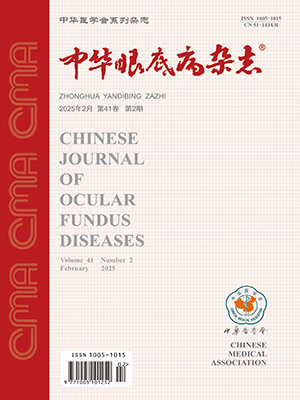| 1. |
Driban M, Kedia N, Arora S, et al. Novel pharmaceuticals for the management of retinal vein occlusion and linked disorders[J]. Expert Rev Clin Pharmacol, 2023, 16(11): 1125-1139. DOI: 10.1080/17512433.2023.2277882.
|
| 2. |
安宁, 杨相颖, 张福燕, 等. 视网膜静脉阻塞的药物治疗进展[J]. 世界临床药物, 2021, 42(4): 314-320. DOI: 10.13683/j.wph.2021.04.015.An N, Yang XY, Zhang FY, et al. Progress in medication treatment of retinal vein occlusion[J]. World Clinical Drugs, 2021, 42(4): 314-320. DOI: 10.13683/j.wph.2021.04.015.
|
| 3. |
中华医学会眼科学分会眼底病学组, 中国医师协会眼科医师分会眼底病专业委员会. 中国视网膜静脉阻塞临床诊疗路径专家共识[J]. 中华眼底病杂志, 2024, 40(3): 175-185. DOI: 10.3760/cma.j.cn511434-20240201-00056.Fundus Diseases Group in Ophthalmology Branch of Chinese Medical Association, Professional Committee of Fundus Diseases in Ophthalmology Branch of Chinese Medical Doctor Association. Expert consensus on clinical diagnosis and treatment path of retinal vein occlusion in China[J]. Chin J Ocul Fundus Dis, 2024, 40(3): 175-185. DOI: 10.3760/cma.j.cn511434-20240201-00056.
|
| 4. |
Gass A. Central retinal venous obstruction[M]//Gass A. Gass’Atlas of macular diseases. 5th eds. Holand: Academic Press, Elsevier, 2011: 588.
|
| 5. |
Jaulim A, Ahmed B, Khanam T, et al. Branch retinal vein occlusion: epidemiology, pathogenesis, risk factors, clinical features, diagnosis, and complications. An update of the literature[J]. Retina, 2013, 33(5): 901-910. DOI: 10.1097/IAE.0b013e3182870c15.
|
| 6. |
Rong AJ, Swaminathan SS, Vanner EA, et al. Predictors of neovascular glaucoma in central retinal vein occlusion[J]. Am J Ophthalmol, 2019, 204: 62-69. DOI: 10.1016/j.ajo.2019.02.038.
|
| 7. |
Ryu CL, Elfersy A, Desai U, et al. The effect of antivascular endothelial growth factor therapy on the development of neovascular glaucoma after central retinal vein occlusion: a retrospective analysis[J/OL]. J Ophthalmol, 2014, 2014: 317694[2014-04-01]. https://pubmed.ncbi.nlm.nih.gov/24800060/. DOI: 10.1155/2014/317694.
|
| 8. |
李水, 杨华静, 代家乐, 等. 视网膜静脉阻塞机制及危险因素研究进展[J]. 国际眼科杂志, 2024, 24(1): 72-76. DOI: 10.3980/j.issn.1672-5123.2024.1.14.Li S, Yang HJ, Dai JL, et al. Research progress of mechanism and risk factors of retinal vein occlusion[J]. Int Eye Sci, 2024, 24(1): 72-76. DOI: 10.3980/j.issn.1672-5123.2024.1.14.
|
| 9. |
Campochiaro PA, Sophie R, Pearlman J, et al. Long-term outcomes in patients with retinal vein occlusion treated with ranibizumab: the RETAIN study[J]. Ophthalmology, 2014, 121(1): 209-219. DOI: 10.1016/j.ophtha.2013.08.038.
|
| 10. |
Lashay A, Riazi-Esfahani H, Mirghorbani M, et al. Intravitreal medications for retinal vein occlusion: systematic review and meta-analysis[J]. J Ophthalmic Vis Res, 2019, 14(3): 336-366. DOI: 10.18502/jovr.v14i3.4791.
|
| 11. |
Massa H, Georgoudis P, Panos GD. Dexamethasone intravitreal implant (OZURDEX?) for macular edema secondary to noninfectious uveitis: a review of the literature[J]. Ther Deliv, 2019, 10(6): 343-351. DOI: 10.4155/tde-2019-0024.
|
| 12. |
Flaxel CJ, Adelman RA, Bailey ST, et al. Retinal vein occlusions preferred practice pattern?[J]. Ophthalmology, 2020, 127(2): 288-320. DOI: 10.1016/j.ophtha.2019.09.029.
|
| 13. |
Berger AR, Cruess AF, Altomare F, et al. Optimal treatment of retinal vein occlusion: Canadian expert consensus[J]. Ophthalmologica, 2015, 234(1): 6-25. DOI: 10.1159/000381357.
|
| 14. |
Campochiaro PA, Heier JS, Feiner L, et al. Ranibizumab for macular edema following branch retinal vein occlusion: six-month primary end point results of a phase Ⅲ study[J]. Ophthalmology, 2010, 117(6): 1102-1112. DOI: 10.1016/j.ophtha.2010.02.021.
|
| 15. |
Campochiaro PA, Brown DM, Awh CC, et al. Sustained benefits from ranibizumab for macular edema following central retinal vein occlusion: twelve-month outcomes of a phase Ⅲ study[J]. Ophthalmology, 2011, 118(10): 2041-2049. DOI: 10.1016/j.ophtha.2011.02.038.
|
| 16. |
Li X, Wang N, Liang X, et al. Safety and efficacy of dexamethasone intravitreal implant for treatment of macular edema secondary to retinal vein occlusion in Chinese patients: randomized, sham-controlled, multicenter study[J]. Graefe's Arch Clin Exp Ophthalmol, 2018, 256(1): 59-69. DOI: 10.1007/s00417-017-3831-6.
|
| 17. |
Schmidt-Erfurth U, Garcia-Arumi J, Gerendas BS, et al. Guidelines for the management of retinal vein occlusion by the European Society of Retina Specialists (EURETINA)[J]. Ophthalmologica, 2019, 242(3): 123-162. DOI: 10.1159/000502041.
|
| 18. |
Hayreh SS. Photocoagulation for retinal vein occlusion[J/OL]. Prog Retin Eye Res, 2021, 85: 100964[2021-03-11]. https://pubmed.ncbi.nlm.nih.gov/33713810/. DOI: 10.1016/j.preteyeres.2021.100964.
|
| 19. |
The Central Vein Occlusion Study Group. A randomized clinical trial of early panretinal photocoagulation for ischemic central vein occlusion[J]. Ophthalmology, 1995, 102(10): 1434-1444. DOI: 10.1016/S0161-6420(95)30848-2.
|
| 20. |
Khayat M, Williams M, Lois N. Ischemic retinal vein occlusion: characterizing the more severe spectrum of retinal vein occlusion[J]. Surv Ophthalmol, 2018, 63(6): 816-850. DOI: 10.1016/j.survophthal.2018.04.005.
|
| 21. |
An W, Han J. Research progress of UWFFA and OCTA in retinal vein occlusion: a review[J]. Eur J Ophthalmol, 2021, 31(6): 2850-2855. DOI: 10.1177/11206721211027411.
|
| 22. |
Tsai G, Banaee T, Conti FF, et al. Optical coherence tomography angiography in eyes with retinal vein occlusion[J]. J Ophthalmic Vis Res, 2018, 13(3): 315-332. DOI: 10.4103/jovr.jovr_264_17.
|




